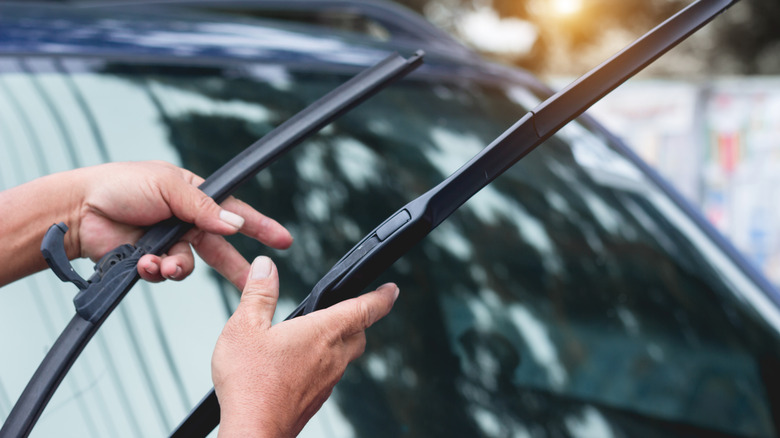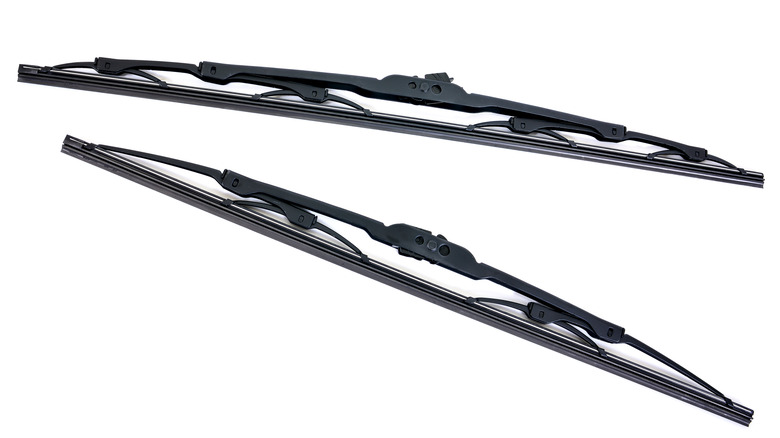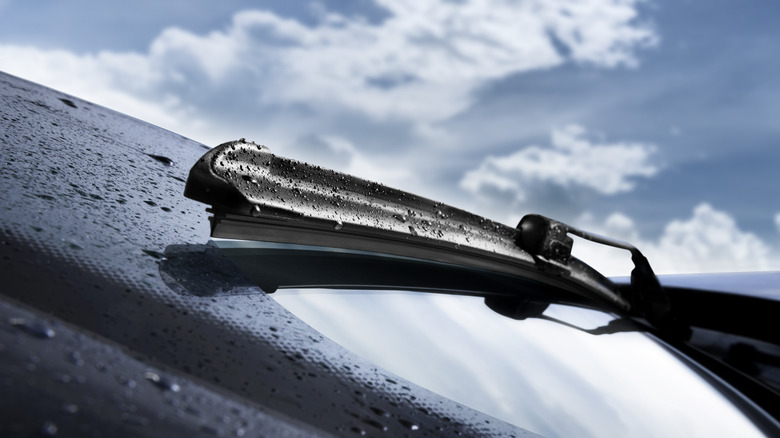Are Left And Right Wiper Blades Interchangeable?
Unless you drive one of a handful of vehicles designed to operate with only one wiper arm — for example, a Cybertruck, or a Toyota Yaris — you will generally see two wiper blades swiping across your windshield in the rain. Depending on how well these blades are maintained, one might provide better visibility than the other, prompting you to wonder: are left and right wiper blades interchangeable?
The long and short of it is that wiper blades come in different lengths — often on the same vehicle. Replacement wiper blades on most newer cars are a pair of curved, frameless assemblies called "beam blades" that clip onto the wiper arm with various connections. Many older cars and trucks use conventional wiper blade refills, straight rubber squeegies slotted into metal frames, held in place with an arrow-shaped catch.
If your vehicle's wiper blade frames are the same length, these conventional rubber refills can easily be swapped from left to right. If one frame is shorter than the other, the longer refill can be cut down to fit. However, putting a shorter refill into a longer frame — which is usually on the driver's side — will leave an empty part of the metal frame free to scratch the windshield. Swapping the frames over is an option, but the longer frame may then interfere with the mechanism, while the shorter blade could impair the driver's vision with incomplete coverage. Another solution would be to revitalize the worn blades with a rag soaked in WD-40, or replace both blades together.
Beam blades are a curve ball
With the above caveats in mind, your conventional, straight windshield wiper frames or blades can be interchanged — provided they give sufficient contact, coverage, and clearance. But can the same be said for the curved beam blades on modern vehicles? Unlike conventional wiper blades, newer beam blades come as a complete assembly, rather than as a frame with a refillable blade, and are curved to fit the contour of the windshield.
Replacement beam blades cost more than old-style refills, ranging in quality from excellent to less than ordinary. The sprung pressure of the wiper arms holds these wiper blades against the windshield, with their curved rubber pressed down onto the glass to follow its contours. Beam blades use at least half a dozen different types of connectors to attach to the wiper arm — with the J-hook, side-pin, top-button among the most common. Aftermarket blades come with adapters to suit each type of connection, but even so, it can be an exercise in frustration working out how they unclip.
Replacement pairs are designed to fit specific vehicles, with the passenger and driver side blades marked as such. As with conventional blades, one beam blade is usually longer than the other. Some auto parts suppliers suggest there might be a slight variation in angle or profile of the left and right blades, but the single most important factor limiting your ability to swap blades from left to right will be the blade length.
When should I replace my wiper blades?
If you follow the proper steps to maintain your wiper blades, they should last from one winter to the next. Most service technicians say rubber wiper blades should be replaced at least once a year, or sooner if they are cracked, torn, or have missing pieces. Similarly, you should replace your wiper blades if they are squeaking, skipping, or chattering across your windshield, or if they leave patches and streaks that impair vision. If you have a rear wiper blade, it is a good idea to replace it at the same time.
Wiper blades have come a long way since the days when drivers wiped down a windshield manually with a piece of cloth. And while wiping by hand makes changing from left to the right simple, it is not at all convenient, especially when traveling long distances down the highway in sleet, rain, or snow. In 1922, Cadillac became the first auto manufacturer to fit its cars with automatic wiper blades, and within a couple of decades, wipers had become a standard safety item on all vehicles.
As well as having a curved profile, modern wiper blades are now also being made from silicone as well as rubber. Silicone is more durable, particularly in extreme weather, with the blades less prone to squeaking. Teflon is also being used to improve blade edge technology, with less wear and a more consistent wiping pattern. However, the rubber blade remains the mainstay of the industry.


